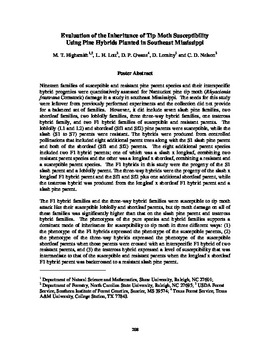| dc.contributor.author | Highsmith, M. T. | |
| dc.contributor.author | Lott, L. H. | |
| dc.contributor.author | Gwaze, D. P. | |
| dc.contributor.author | Lominy, D. | |
| dc.contributor.author | Nelson, C. D. | |
| dc.date.accessioned | 2016-04-25T19:36:06Z | |
| dc.date.available | 2016-04-25T19:36:06Z | |
| dc.date.issued | 2003 | |
| dc.identifier | oksd_sf27_p208.pdf | |
| dc.identifier.citation | Highsmith, M. T., Lott, L. H., Gwaze, D. P., Lominy, D., & Nelson, C. D. (2003). "Evaluation of the Inheritance of Tip Moth Susceptibility Using Pine Hybrids Planted in Southeast Mississippi." In 27th Southern Forest Tree Improvement Conference, Stillwater, OK | |
| dc.identifier.uri | https://hdl.handle.net/11244/33699 | |
| dc.description.abstract | Nineteen families of susceptible and resistant pine parent species and their interspecific hybrid progenies were quantitatively assessed for Nantucket pine tip moth (Rhyacionia frustrana Comstock) damage in a study in southeast Mississippi. The seeds for this study were leftover from previously performed experiments and the collection did not provide for a balanced set of families. However, it did include seven slash pine families, two shortleaf families, two loblolly families, three three-way hybrid families, one testcross hybrid family, and two F1 hybrid families of susceptible and resistant parents. The loblolly (L1 and L2) and shortleaf (Sf1 and Sf2) pine parents were susceptible, while the slash (S1 to S7) parents were resistant. The hybrids were produced from controlled pollinations that included eight additional parent trees along with the S1 slash pine parent and both of the shortleaf (Sf1 and Sf2) parents. The eight additional parent species included two F1 hybrid parents; one of which was a slash x longleaf, combining two resistant parent species and the other was a longleaf x shortleaf, combining a resistant and a susceptible parent species. The F1 hybrids in this study were the progeny of the S1 slash parent and a loblolly parent. The three-way hybrids were the progeny of the slash x longleaf F1 hybrid parent and the Sf1 and Sf2 plus one additional shortleaf parent, while the testcross hybrid was produced from the longleaf x shortleaf F1 hybrid parent and a slash pine parent. The F1 hybrid families and the three-way hybrid families were susceptible to tip moth attack like their susceptible loblolly and shortleaf parents, but tip moth damage on all of these families was significantly higher than that on the slash pine parent and testcross hybrid families. The phenotypes of the pure species and hybrid families supports a dominant mode of inheritance for susceptibility to tip moth in three different ways: (1) the phenotype of the F1 hybrids expressed the phenotype of the susceptible parents, (2) the phenotype of the three-way hybrids expressed the phenotype of the susceptible shortleaf parents when those parents were crossed with an interspecific F1 hybrid of two resistant parents, and (3) the testcross hybrid expressed a level of susceptibility that was intermediate to that of the susceptible and resistant parents when the longleaf x shortleaf F1 hybrid parent was backcrossed to a resistant slash pine parent. | |
| dc.format | application/pdf | |
| dc.language | en_US | |
| dc.relation.ispartofseries | Sponsored publication . . . of the Southern Forest Tree Improvement Committee ; no. 49 | |
| dc.rights | This paper is made available through open access and the auspices of the fair use doctrine for scholarly, educational and research purposes while recognizing the publisher already offers a free online version. The OSU Library�s intent is to offer access and preserve publications involving its faculty contributions. Contact the Digital Resources and Discovery Services at lib-dls@okstate.edu or 405-744-9161 for the permission policy on the use, reproduction or distribution of this material. | |
| dc.source | Proceedings of the 27th Southern Forest Tree Improvement Conference, volume 27, 2003. Editor, Craig R. McKinley. | |
| dc.title | Evaluation of the Inheritance of Tip Moth Susceptibility Using Pine Hybrids Planted in Southeast Mississippi | |
| dc.type | text | |
| osu.filename | oksd_sf27_p208.pdf | |
| dc.type.genre | Conference proceedings | |
| dc.description.scopeandcontents | Papers and abstracts from the 27th Southern Forest Tree Improvement Conference held at Oklahoma State University in Stillwater, Oklahoma on June 24-27, 2003. | |
